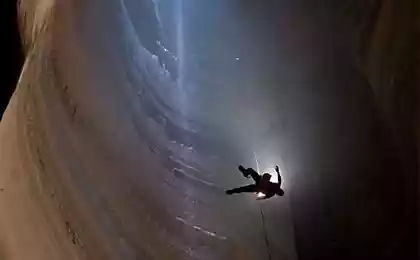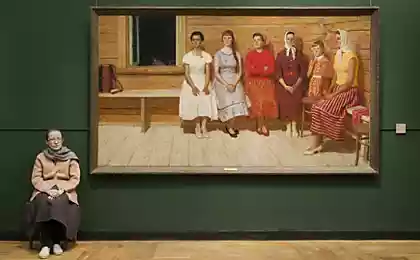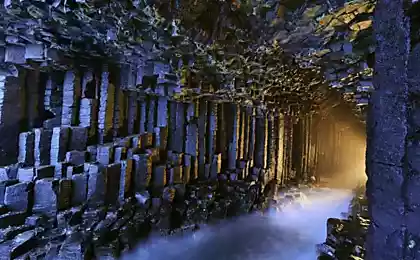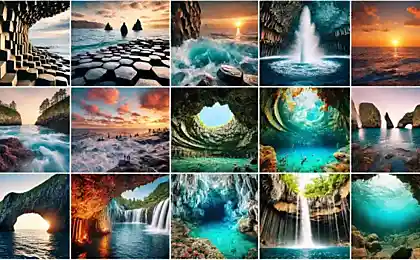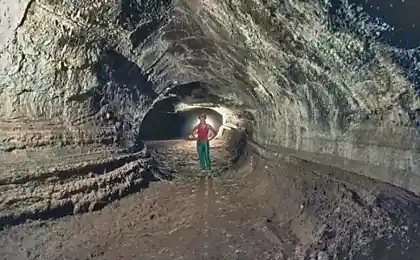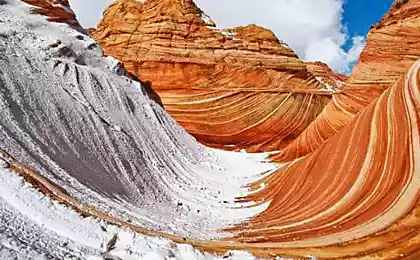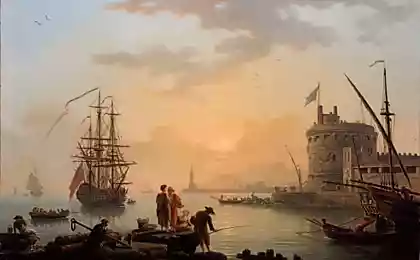1795
Magura Cave (22 photos)
One of the largest caves in Bulgaria is the Magura cave. It was formed in the limestone Rabishkom mound, at an altitude of 461 meters above sea level.
The formation of the cave began about 15 million. Years ago, and the total length of about 2600 meters.

The cave "Magura" is located 35 kilometers southwest of the town of Vidin on the Danube River in north-western Bulgaria. It consists of a main gallery and three side branches. Our tour began with a lower left part of the circuit, we have come to the right end, but did not go there, and came back ... The tour is only in Bulgarian. This scheme will help if you want to navigate in our story.
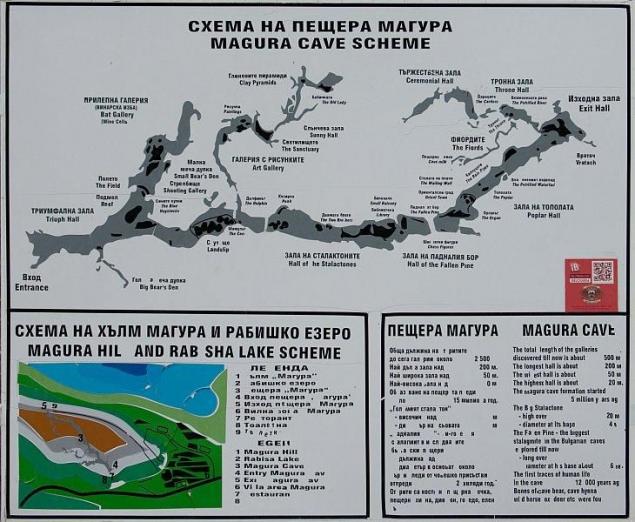
It looks like the first room of the cave - Triumphant in which you find yourself on the input tunnel (a tunnel out to the left in the photo). Room Dimensions are impressive: length 128 meters, width 58 meters and height of 28 meters. Earlier on a river cave, but then there was a failure of the karst and the river changed its channel, forming a lake not far from the cave. The natural entrance to the cave is almost vertical and inaccessible without special equipment, so for convenience, was cut through another entrance. The cave is lit, although it is still not as bright as it turns out in the photo long exposure. Rather, it reigns a mysterious gloom, causing the hard work your imagination
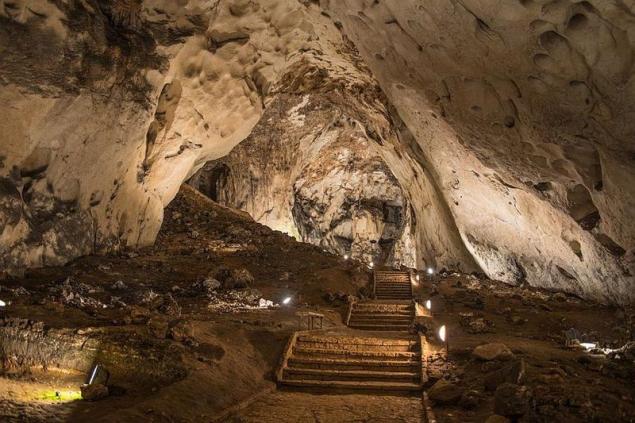
In the cave year-round temperature of 12 degrees keeps and very humid. Moving through the cave, we noted signs of shortness of breath, and came out of her clothes were all wet from the cave have absorbed moisture. Plus visit the caves in winter, except that no one nation in the fact that the street winter, the temperature and the heat in the cave continue our way through the triumphal hall into the cave ...
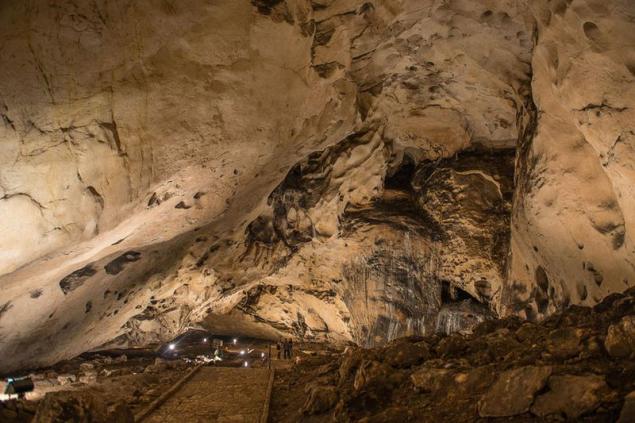
Here there are several species of bats, beetles, woodlice, fungi. we saw two large colony of bats. Some mice were hung directly on the wall, past which we were, and they could see and touch (they do not react to it). The cave was found the bones of cave bear, cave hyena, and other
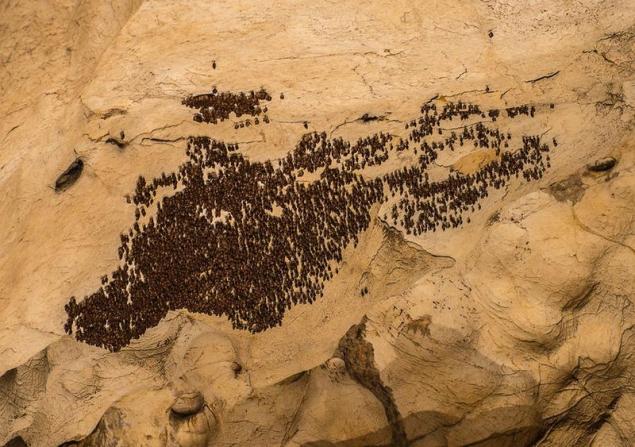
The cave is used for the production of shampanizirovannyh and red wines, aged in natural conditions, close to those of the production of French champagne. That's just the photo below room where the wine used to do. Now the winery is located on a branch from this room (Vinarsko hut in the diagram) and just not available to tourists

Man lived here during the Bronze and early Iron Age. The first archaeological studies were made in 1927. V. Mihov, were found fragments of pottery from the Neolithic to the Late Bronze Age. The spacious reefs over a wide area were found at home, stoves, tools (scrapers, knives, awls, ornaments) made of flint, stone, bone and antler. Found and ceramics. The homes were built of mud, attached to the floor of wooden stakes at a distance of 25 cm from each other and also with clay plaster. Roofs of houses were the vaults of the cave. The floor was made from yellow clay. Furnaces were rectangular shaped with dimensions of 1, 3 x1, 1m
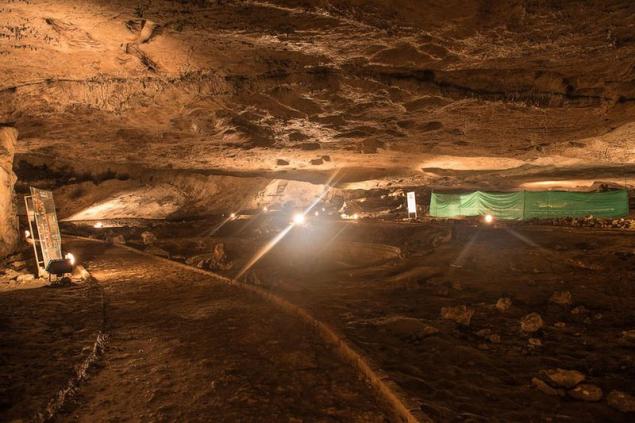
Go to the next room ...
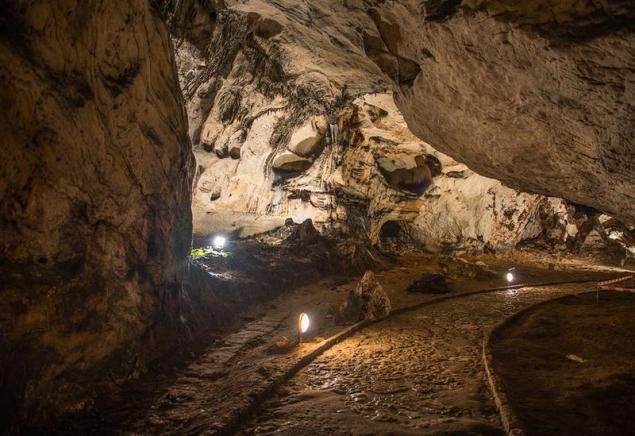
The next room is called the landslide. Its area is 2800 square meters, 85 meters in length, 68 meters in width and height on the west side up to 27 meters. In the hall a lot of boulders torn from the walls and ceiling
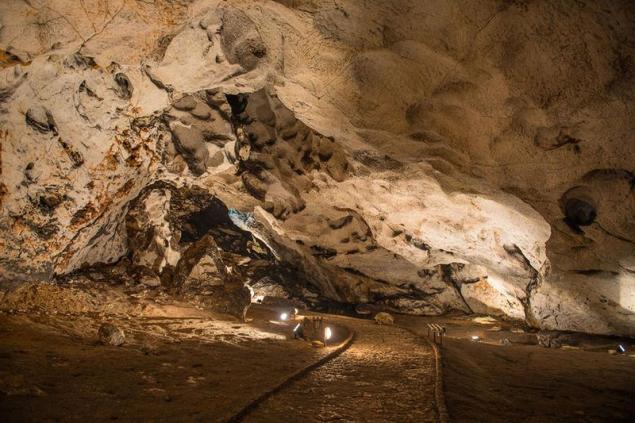
Hall stalacton, so named because of the huge stalacton in the heart. "Great stalacton" height of over 20 meters, and the diameter of its base - 4 meters. Yes, by the way, remember that: Stalactites (Gr. Σταλακτίτης - «natёkshy drop by drop") - beds of sediments in karst caves in the form of structures, suspended from the ceiling (icicles, straw, comb, fringe and so on. N.). Stalagmites (from the Greek. Σταλαγμίτης - drop) - natёchnye mineral formations (mostly lime, less gypsum, salt), growing in the form of cones, columns from the bottom of caves and other underground caverns to meet the stalactites. Stalagnates or stalacton - sinter-drip beds of sediment in karst caves. Stalagnates are kolonnopodobnye education due to the juxtaposition of stalactites and stalagmites.
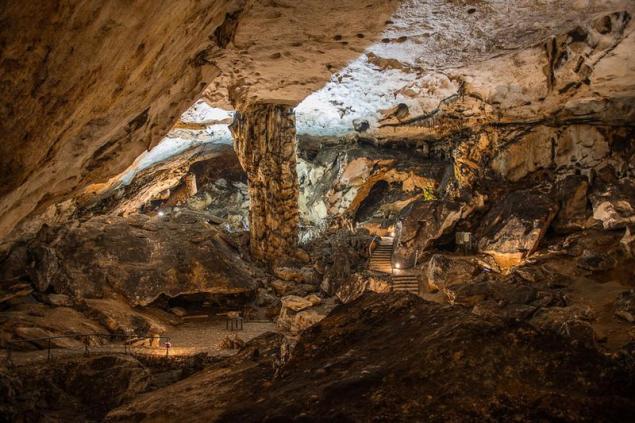
This huge boulder 19 × 24 meters came off the top of the wall. Now here is something like a concert venue. We, however, did not find the performance (perhaps it was because we were only four in the cave?
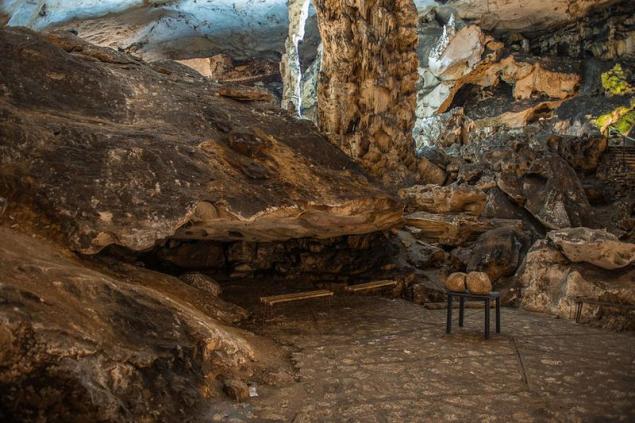
General view of the hall from the opposite end

Go ahead ... Almost every cave we've seen there is a place where coins are left to come zagadyvaniya different nishtyakov
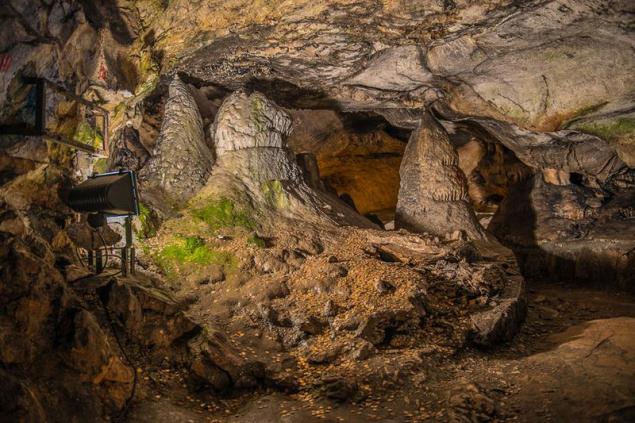
This room is called "Fallen Pine", covers an area of square meters 3590 Dimensions: 102 meters long, 48 meters wide with a maximum height of 14 meters. The name of the room is associated with a large stalagmite fallen 11 long, 4 meters in diameter at the base of 6m. In the foreground - a stalagmite Dragon, height 2, 6 m. The northern part of this room is the lowest point of the cave, which is 50 hectares of meters below the entrance
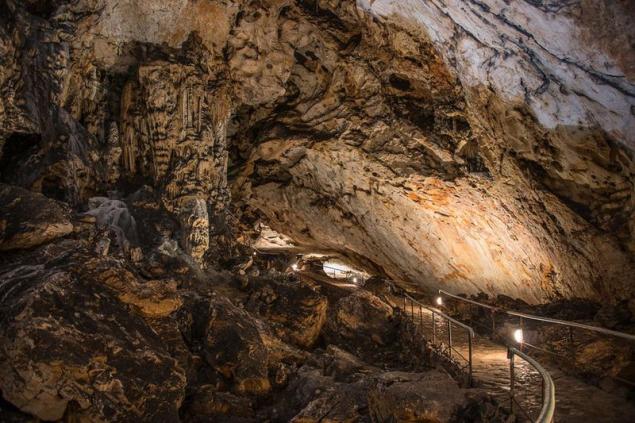
This figure could not be identified yet, perhaps it's "body" or "Oriental City»
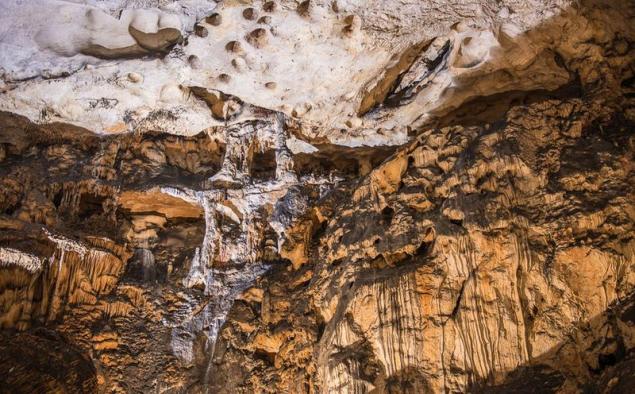
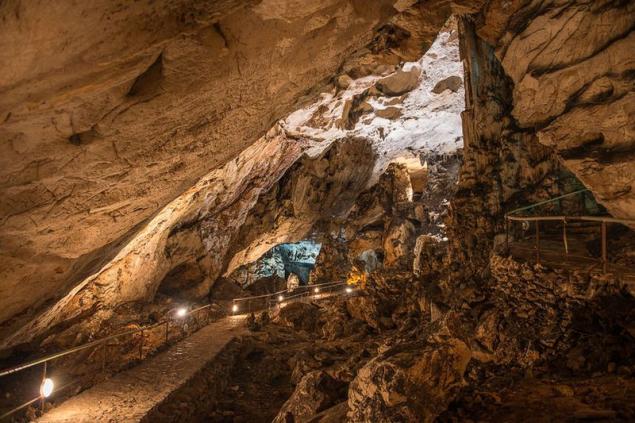
Go to the gym, "Topol". Green highlighted the cornice on the "Wailing Wall»
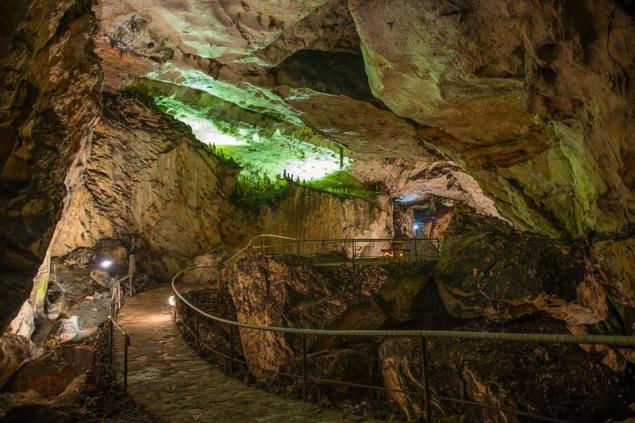
The length of the room from 121 to 35 meters, a maximum height of 21 m and covers an area of square meters 3390 The Hall miraculously survived slender stalagmite height of 6, 2 m, which is called a poplar. On the left in the photo - vertical "Wailing Wall", which ends with a large terrace (highlighted in green), topped with a small beautiful stalagmites "Baghdad»
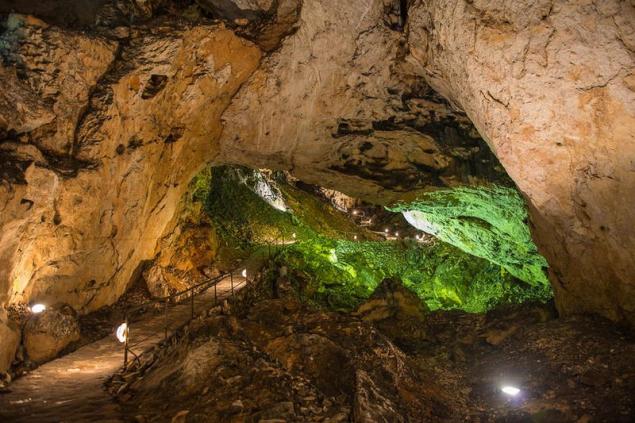
At the end of poplar hall out of the cave. He was currently closed
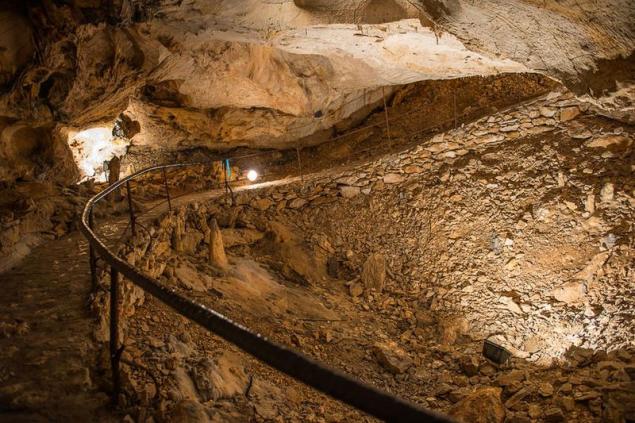
Left out of the exit path in the "Throne Room»
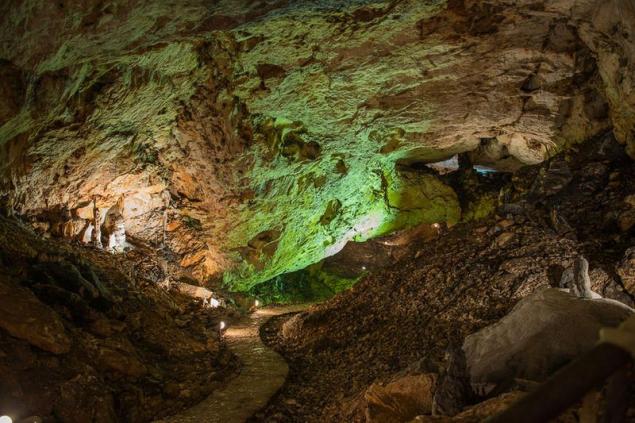
That's because of the construction on the left called the throne room
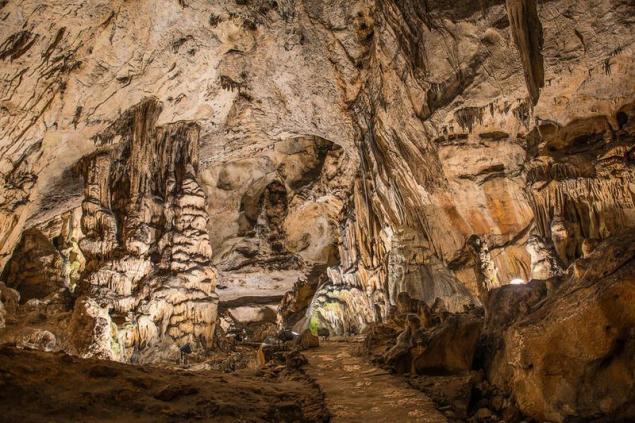

Pass on the photo is a closed branch of the cave, which was used for medicinal purposes since the 50s of the twentieth century. On the healing properties of the climate sylvinite caves of the earth's population has known since ancient times. "Speleyon" in Greek - Cave. Scientific sources say sylvinite caves were used by the priests-vrachevatelemi for the treatment of the ruling elite in ancient Greece. On the beneficial effects of salt caves Silvinit-noticed in a cave in Germany Klyutert in 1945. The cave was used as a medical unit and a bomb shelter during World War II. It has been observed that patients with asthma who were in the bomb shelter, stop asthma attacks, coughing, facilitates breathing, improves health, patients recover faster. Cave Klyutert currently used by German doctors to treat patients with diseases of the immune system, respiratory, allergic diseases and other diseases. Sylvinite natural mines and development began to be used for treatment in all countries where they exist. Sanatorium (ex Ceremonial hall) was transformed into a temporary hospital - sanatorium "Magura Cave" with 30 beds for patients with bronchial asthma. Experiments with patients 1974-75 gave good results. Favourable climatic conditions in the room (absolutely clean air without allergens, a constant temperature of 11-12, constant humidity, very good ionization, isolation from outside noise and special lighting), creating the most appropriate psychological condition in bronchial asthma. Thus, patients receive a significant relief from breathing problems. Unfortunately, we did not get to that part of the cave where the cave paintings: pass probably there, we would be able to, but narrow and very long passage was lit and we could not even figure out where we go (we did not have a flashlight) and slippery floor with steep ascents, descents and sharp stones everywhere on did not have to fotopodvigam. Rock paintings are made with the help of bat guano. These multi-layer, dated to various epochs - epipaleolitom, Neolithic, Eneolithic, Early Bronze epoch beginning. If desired, they can be easy to find photos in the internet.

Source: www.liveinternet.ru
The formation of the cave began about 15 million. Years ago, and the total length of about 2600 meters.

The cave "Magura" is located 35 kilometers southwest of the town of Vidin on the Danube River in north-western Bulgaria. It consists of a main gallery and three side branches. Our tour began with a lower left part of the circuit, we have come to the right end, but did not go there, and came back ... The tour is only in Bulgarian. This scheme will help if you want to navigate in our story.

It looks like the first room of the cave - Triumphant in which you find yourself on the input tunnel (a tunnel out to the left in the photo). Room Dimensions are impressive: length 128 meters, width 58 meters and height of 28 meters. Earlier on a river cave, but then there was a failure of the karst and the river changed its channel, forming a lake not far from the cave. The natural entrance to the cave is almost vertical and inaccessible without special equipment, so for convenience, was cut through another entrance. The cave is lit, although it is still not as bright as it turns out in the photo long exposure. Rather, it reigns a mysterious gloom, causing the hard work your imagination

In the cave year-round temperature of 12 degrees keeps and very humid. Moving through the cave, we noted signs of shortness of breath, and came out of her clothes were all wet from the cave have absorbed moisture. Plus visit the caves in winter, except that no one nation in the fact that the street winter, the temperature and the heat in the cave continue our way through the triumphal hall into the cave ...

Here there are several species of bats, beetles, woodlice, fungi. we saw two large colony of bats. Some mice were hung directly on the wall, past which we were, and they could see and touch (they do not react to it). The cave was found the bones of cave bear, cave hyena, and other

The cave is used for the production of shampanizirovannyh and red wines, aged in natural conditions, close to those of the production of French champagne. That's just the photo below room where the wine used to do. Now the winery is located on a branch from this room (Vinarsko hut in the diagram) and just not available to tourists

Man lived here during the Bronze and early Iron Age. The first archaeological studies were made in 1927. V. Mihov, were found fragments of pottery from the Neolithic to the Late Bronze Age. The spacious reefs over a wide area were found at home, stoves, tools (scrapers, knives, awls, ornaments) made of flint, stone, bone and antler. Found and ceramics. The homes were built of mud, attached to the floor of wooden stakes at a distance of 25 cm from each other and also with clay plaster. Roofs of houses were the vaults of the cave. The floor was made from yellow clay. Furnaces were rectangular shaped with dimensions of 1, 3 x1, 1m

Go to the next room ...

The next room is called the landslide. Its area is 2800 square meters, 85 meters in length, 68 meters in width and height on the west side up to 27 meters. In the hall a lot of boulders torn from the walls and ceiling

Hall stalacton, so named because of the huge stalacton in the heart. "Great stalacton" height of over 20 meters, and the diameter of its base - 4 meters. Yes, by the way, remember that: Stalactites (Gr. Σταλακτίτης - «natёkshy drop by drop") - beds of sediments in karst caves in the form of structures, suspended from the ceiling (icicles, straw, comb, fringe and so on. N.). Stalagmites (from the Greek. Σταλαγμίτης - drop) - natёchnye mineral formations (mostly lime, less gypsum, salt), growing in the form of cones, columns from the bottom of caves and other underground caverns to meet the stalactites. Stalagnates or stalacton - sinter-drip beds of sediment in karst caves. Stalagnates are kolonnopodobnye education due to the juxtaposition of stalactites and stalagmites.

This huge boulder 19 × 24 meters came off the top of the wall. Now here is something like a concert venue. We, however, did not find the performance (perhaps it was because we were only four in the cave?

General view of the hall from the opposite end

Go ahead ... Almost every cave we've seen there is a place where coins are left to come zagadyvaniya different nishtyakov

This room is called "Fallen Pine", covers an area of square meters 3590 Dimensions: 102 meters long, 48 meters wide with a maximum height of 14 meters. The name of the room is associated with a large stalagmite fallen 11 long, 4 meters in diameter at the base of 6m. In the foreground - a stalagmite Dragon, height 2, 6 m. The northern part of this room is the lowest point of the cave, which is 50 hectares of meters below the entrance

This figure could not be identified yet, perhaps it's "body" or "Oriental City»


Go to the gym, "Topol". Green highlighted the cornice on the "Wailing Wall»

The length of the room from 121 to 35 meters, a maximum height of 21 m and covers an area of square meters 3390 The Hall miraculously survived slender stalagmite height of 6, 2 m, which is called a poplar. On the left in the photo - vertical "Wailing Wall", which ends with a large terrace (highlighted in green), topped with a small beautiful stalagmites "Baghdad»

At the end of poplar hall out of the cave. He was currently closed

Left out of the exit path in the "Throne Room»

That's because of the construction on the left called the throne room


Pass on the photo is a closed branch of the cave, which was used for medicinal purposes since the 50s of the twentieth century. On the healing properties of the climate sylvinite caves of the earth's population has known since ancient times. "Speleyon" in Greek - Cave. Scientific sources say sylvinite caves were used by the priests-vrachevatelemi for the treatment of the ruling elite in ancient Greece. On the beneficial effects of salt caves Silvinit-noticed in a cave in Germany Klyutert in 1945. The cave was used as a medical unit and a bomb shelter during World War II. It has been observed that patients with asthma who were in the bomb shelter, stop asthma attacks, coughing, facilitates breathing, improves health, patients recover faster. Cave Klyutert currently used by German doctors to treat patients with diseases of the immune system, respiratory, allergic diseases and other diseases. Sylvinite natural mines and development began to be used for treatment in all countries where they exist. Sanatorium (ex Ceremonial hall) was transformed into a temporary hospital - sanatorium "Magura Cave" with 30 beds for patients with bronchial asthma. Experiments with patients 1974-75 gave good results. Favourable climatic conditions in the room (absolutely clean air without allergens, a constant temperature of 11-12, constant humidity, very good ionization, isolation from outside noise and special lighting), creating the most appropriate psychological condition in bronchial asthma. Thus, patients receive a significant relief from breathing problems. Unfortunately, we did not get to that part of the cave where the cave paintings: pass probably there, we would be able to, but narrow and very long passage was lit and we could not even figure out where we go (we did not have a flashlight) and slippery floor with steep ascents, descents and sharp stones everywhere on did not have to fotopodvigam. Rock paintings are made with the help of bat guano. These multi-layer, dated to various epochs - epipaleolitom, Neolithic, Eneolithic, Early Bronze epoch beginning. If desired, they can be easy to find photos in the internet.

Source: www.liveinternet.ru
